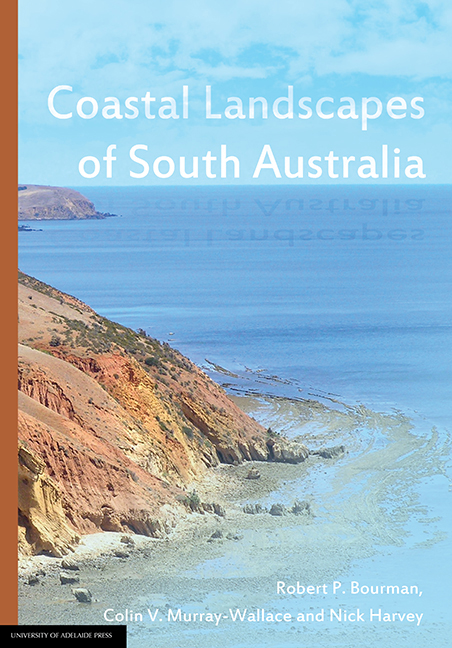Book contents
- Frontmatter
- Dedication
- Contents
- Preface
- Biographies
- Acknowledgements
- 1 Coastal landscapes of South Australia
- 2 The coast of metropolitan Adelaide
- 3 The Fleurieu Peninsula coast
- 4 The River Murray Estuary
- 5 The Coorong Coastal Plain and the Limestone Coast
- 6 The northern Gulf St Vincent tidal coastline (the Samphire Coast)
- 7 The Yorke Peninsula coastline
- 8 The northern Spencer Gulf coast
- 9 The Gulf Coast of Eyre Peninsula
- 10 The Bight Coast - West coast of Eyre Peninsula
- 11 Kangaroo Island
- 12 Explaining the coastal landscapes of South Australia - A synthesis
8 - The northern Spencer Gulf coast
Published online by Cambridge University Press: 25 July 2017
- Frontmatter
- Dedication
- Contents
- Preface
- Biographies
- Acknowledgements
- 1 Coastal landscapes of South Australia
- 2 The coast of metropolitan Adelaide
- 3 The Fleurieu Peninsula coast
- 4 The River Murray Estuary
- 5 The Coorong Coastal Plain and the Limestone Coast
- 6 The northern Gulf St Vincent tidal coastline (the Samphire Coast)
- 7 The Yorke Peninsula coastline
- 8 The northern Spencer Gulf coast
- 9 The Gulf Coast of Eyre Peninsula
- 10 The Bight Coast - West coast of Eyre Peninsula
- 11 Kangaroo Island
- 12 Explaining the coastal landscapes of South Australia - A synthesis
Summary
Introduction
Northern Spencer Gulf encompasses the coastline that extends north from Whyalla to Port Augusta on the eastern Eyre Peninsula and from Port Augusta to Port Broughton on Yorke Peninsula (Figure 8.1). Northern Spencer Gulf is an inverse or negative estuary where evaporation exceeds freshwater input, with salinities (34 to 49 ppt, or parts per thousand) increasing in the northernmost portion of the gulf. Water temperatures are also elevated, ranging between 13 to 28°C. The gulf thus provides a refuge for plants and animals that colonised during warmer water conditions of the past, such as coralline algae near the bridge crossings at Port Augusta. Protected from the ocean swell, these northernmost gulf areas also experience diminished wave heights but amplified tidal ranges. The tidal ranges typical of the gulf are 2.5 to 3 m, but a maximum tidal range of 4.1 m has been recorded at Port Augusta, which is just into the macrotidal range. There are regular dodge tides every two weeks, when for 1 to 2 days there is no tidal movement due to the two main semi-diurnal tides, M2 and S2, cancelling each other out.
Tidal processes dominate the northern Spencer Gulf, and the coastline is characterised by thick seagrass meadows, wide intertidal sandflats, mangrove woodlands and supratidal saline marshland. Coastal development is intimately related to the massive production and accumulation of biogenic materials including algae, seagrass, molluscs and bryozoans; the site is a ‘major carbonate factory’, sequestering much CO2. Algal mats, seagrass meadows and mangrove woodlands are highly productive environments for the growth of rich and diverse marine organisms that promote the rapid accumulation of skeletal, calcareous, bioclastic debris when they die. Intertidal sandflats produce vast numbers of molluscs that also contribute to the vertical accretion and seaward progradation of the shoreline (Figure 8.2). These processes have been enhanced by a fall in relative sea level over the past 5000 years, stranding shell ridges and supratidal flats, which accumulate gypsum, dolomite and salt.
Geological setting
Between Whyalla and Port Augusta, the basic shape of the shoreline reflects bedrock geology; resistant Proterozoic rocks form shore platforms and headlands that shelter sandy bays. From Point Lowly to Port Augusta, the coast is closely aligned with the Torrens Hinge Zone (see Figure 9.1), a major complex fault that separates the eastern side of the Gawler Craton from the rocks of the Adelaide Geosyncline.
- Type
- Chapter
- Information
- Coastal Landscapes of South Australia , pp. 243 - 272Publisher: The University of Adelaide PressPrint publication year: 2016



